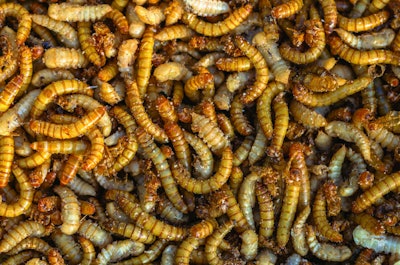
Research project looks to adapt existing feed safety standards in Australia to insect meal
Despite the hype around insects’ ability to upcycle human food waste into animal feed, actually feeding insects raised on trash is prohibited. A group of insect meal researchers in Australia aims to change that.
Academics, government and industry partners participating in a newly launched cooperative research center will spend the next two years studying how Australia’s existing FeedSafe quality assurance program could be applied to insect meal. The project will involve a series of tests designed to evaluate safety considerations for the entire insect meal supply chain, beginning with the substrate on which the insects are raised, in hope of finding criteria that would permit the safe recycling of some of the world’s most difficult waste streams: food waste, animal effluent and human biosolids.
Livestock producers in Australia can feed insect meal to fish and poultry in some jurisdictions, but not to pigs or ruminants, according to Duncan Rowland, executive officer of the Stock Feed Manufacturers’ Council of Australia. Even in species permitted to consume insect meal, the type of substrate permitted is limited to plant-based materials, restrictions that Olympia Yarger, chair of the Insect Protein Association of Australia, believes have prevented insect production from realizing its true potential.
Insects offer a unique opportunity, Yarger said, because they can be reared on a variety of substrates — including waste streams inedible to other species. But limiting commercial substrates to plant-based wastes, she said, means existing insect operations are competing with livestock producers for agricultural waste streams like grain detritus, which Yarger argued relegates insects to the role of unnecessary middle man in the agricultural supply chain.
Completing the research necessary to open up unique substrate options, Yarger said, would allow insects to take their rightful place in the supply chain, recycling previously useless waste streams and creating a new source of protein for animal producers.
“We have to do it now, while the industry is still young, so we can accelerate and scale using waste streams that are not currently dedicated to livestock production,” Yarger said.
To determine the safety of using substrates such as post-consumer waste or biosolids, researchers will test each substrate for potential contaminants and then evaluate whether insects raised on that substrate still contain those contaminants after being processed into meal. For example, household waste streams could contain rat poisons, bleach and cleaning agents, pathogens or even heavy metals. Will the resulting meal pose a threat to livestock?
“The feeling around these kinds of substrates is they are bad and they should not be used in our supply chain,” Yarger said. “That’s not based in science. We need to determine if that is true or not.”
Even if those contaminants do transfer from the substrate to the insect meal, Yarger said that as CEO of waste management startup Goterra, she believes there may still be potential uses for these contaminated insects in bioplastics or biofuels.
“Our job in this research is to qualify the understanding of what substrates mean in the supply chain, and then from there it will be Goterra’s mission to determine what we can do with that insect,” Yarger said. “We have to stop pretending that insects are a one trick pony, and we have to be far more imaginative in how we solve these problems.”














